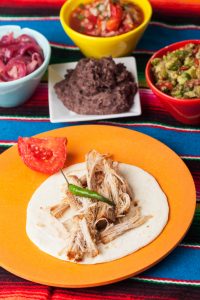 Fine food is as good a reason to visit the Yucatan Peninsula as any! The culinary delights of this region borrow influence from Mayan, Caribbean, Spanish, African, Middle Eastern, and Mexican cuisines. The corn, chocolate, honey, venison, wild turkey, squash, cucumbers, chiles, and tomatoes you see in many Yucatan dishes are remnants of traditional Mayan cooking. Pork and Seville oranges worked their way into the cuisine much later, when Spanish settlers arrived in the 16th century. Edam and Gouda cheese can be owed to trade with the Dutch in the 19th century.
Fine food is as good a reason to visit the Yucatan Peninsula as any! The culinary delights of this region borrow influence from Mayan, Caribbean, Spanish, African, Middle Eastern, and Mexican cuisines. The corn, chocolate, honey, venison, wild turkey, squash, cucumbers, chiles, and tomatoes you see in many Yucatan dishes are remnants of traditional Mayan cooking. Pork and Seville oranges worked their way into the cuisine much later, when Spanish settlers arrived in the 16th century. Edam and Gouda cheese can be owed to trade with the Dutch in the 19th century.
Some restaurant offerings — like ceviche – are common among other Mexican, Caribbean, and Latin American locales, but seasonings like achiote, a peppery red sauce derived from the tropical annatto plant, and Spanish sour orange are unique to the region, and offer a distinctive flavor profile to Yucatan dishes.
Other common seasonings in Yucatan cooking include: pumpkin seed, xcatic chile pepper, habaneros, sweet chili, red onion, tomato, and oregano. Like any coastal environment, seafood is a big part of the cuisine in Baja Mexico and the surrounding area, but turkey, chicken, and pork are prominent proteins.
While in Mexico, you’ll be treated to a multitude of fresh, locally grown spices, fruits, and vegetables that excite the senses. Maybe you’ll taste guacamole and flan like you’ve never tasted before while visiting the Yucatan Peninsula, but here are five local Mexican dishes you’ve never heard of that will be worth trying.
Pibil (pronounced “PEE-beel)
The Yucatan’s most famous local dish translates to “cooked under ground.” In a land of dense jungle and high humidity, the Ancient Mayans had to figure out preservation methods to preserve the wild game they needed to transport home from the hunt. Their version of barbecue involves a spice rub and pit smoke. Modern cooks marinate chicken (Pollo), pork (Puerco), or a whole suckling pig (Cochinita) in achiote paste, onions, and sour orange juice overnight before wrapping the meat in banana leaves and slow-roasting over charcoal. This dish may be served on rolls or tortillas, accompanied by refried beans and pickled red onion relish.
Papadzules (pronounced papa-TSU-les)
Papadzules are simply described as “small egg tacos” smothered in tomato sauce. You can think of it as the Yucatan’s version of the central Mexican taquito, flauta, or enchilada. To make this dish, chefs concoct a sauce by toasting Mayan xt’op or Spanish pepita gruesa pumpkin seeds, grinding them, and extracting the paste. The paste is then blended with epazote, a sharp herb similar to oregano. A fresh corn tortilla is dipped in this sauce and stuffed with chopped hard-boiled egg. The tortilla is deep-fried and simmered in a tomato and habanero chile sauce.
Queso Relleno (pronounced CAY-so re-LAY-nyo)
Hollowed-out Edam cheese is at the heart of this Mexican dish. In the past, “the boss” was fed the soft part of the cheese and left the hard rinds to the servants. They stuffed these cheese rinds with a near-black mixture of caper olives, raisins, Bell peppers, almonds, hardboiled egg, spices, and ground beef or pork – fried until nearly carmelized. The stuffed rinds were then wrapped in cheesecloth and banana leaves, steamed to a molten consistency, and topped with a red tomato sauce and a white gravy called k’ool.
Sopa de Lima (pronounced SOAP-a day LEE-ma)
Lime soup is a broth-based hot soup made with chicken or turkey stock simmered for hours, and combined with shredded chicken, garlic, onion, tomatoes, dried oregano, and (of course) lots of lime juice. This tasty soup is served with fresh garnishes of scallions, cilantro, habanero chiles, and citrus juice – a side known as xnipek, which translates to “dog’s nose” because it’s so spicy, one’s nose starts to run after one taste! Strips of crunchy fried tortilla are often served on top.
Panuchos (pronounced pan-OO-choss)
In America, hotdogs are the traditional “street meat” food cart fare. In the Yucatan Peninsula, Panuchos are the snack of choice, found in food carts, fast food joints, cantinas, and restaurant appetizer menus alike. Handmade corn tortillas are stuffed with refried back beans and shredded chicken marinated in peppery achiote seed paste and dissolved juice of sour orange. Sometimes you’ll see turkey, fish, or pork in place of the chicken, making it a great way to re-use leftovers. Toppings of choice include: pickled red onions and jalapeno pepper, fresh avocados, chopped plum tomato, and chopped lettuce or cabbage. Salbutes are very similar, except that the tortillas are made of corn and flour, not just corn, and are fried until very crispy.
Want to learn more about visiting the Yucatan Peninsula, Mexico? Contact Sea Side Reservations to book your local accommodations and gain insights from experienced travel coordinators who have the inside scoop on the region!
More on Yucatan cuisine:
- The Yucatan Times – Top 10 Authentic Regional Dishes of Yucatan, http://www.theyucatantimes.com/2016/07/top-10-authentic-regional-dishes-of-yucatan/
- Goats on the Road – Eating Our Way Through the Yucatan Peninsula, https://www.goatsontheroad.com/mexican-food-eating-our-way-through-the-yucatan-peninsula/
- Chowhound – How To Pronounce Pibil, https://www.chowhound.com/post/pronounce-pibil-cochinita-300052
- Bacon Is Magic – Must Try Street Food in the Yucatan Peninsula, http://www.baconismagic.ca/food/must-try-street-food-in-the-yucatan-peninsula/
- Food and Wine – A Yucatan Adventure, http://www.foodandwine.com/articles/a-yucatan-adventure
- Loco Gringo – 10 Iconic Yucatan Foods To Try, https://www.locogringo.com/10-iconic-yucatan-foods
- Backyard Nature – Yucatan, http://www.backyardnature.net/m/food/states/yucatan.htm
- Eat Your World – What To Eat: Queso Relleno, http://eatyourworld.com/destinations/mexico/general_mexico/coastal_yucatan/what_to_eat/queso_relleno


